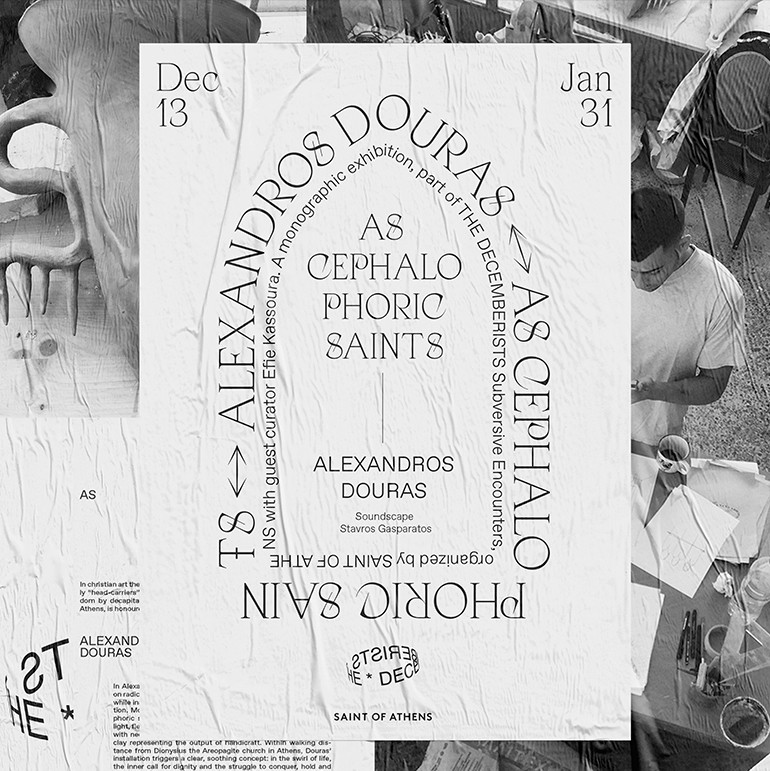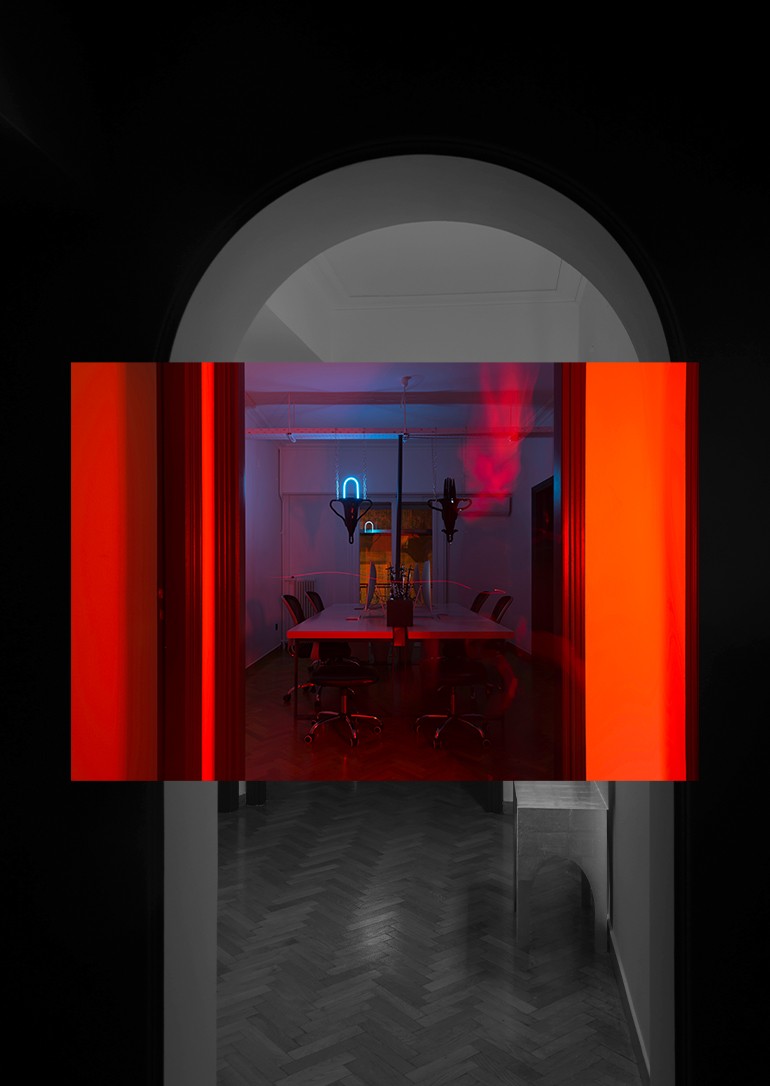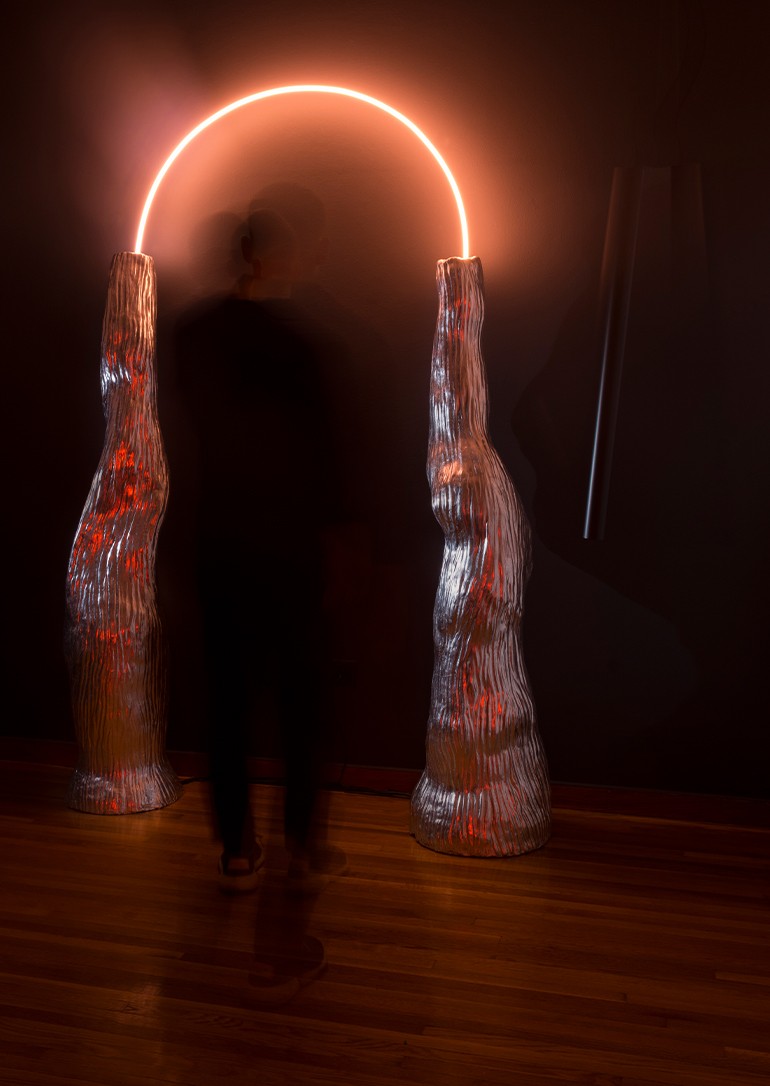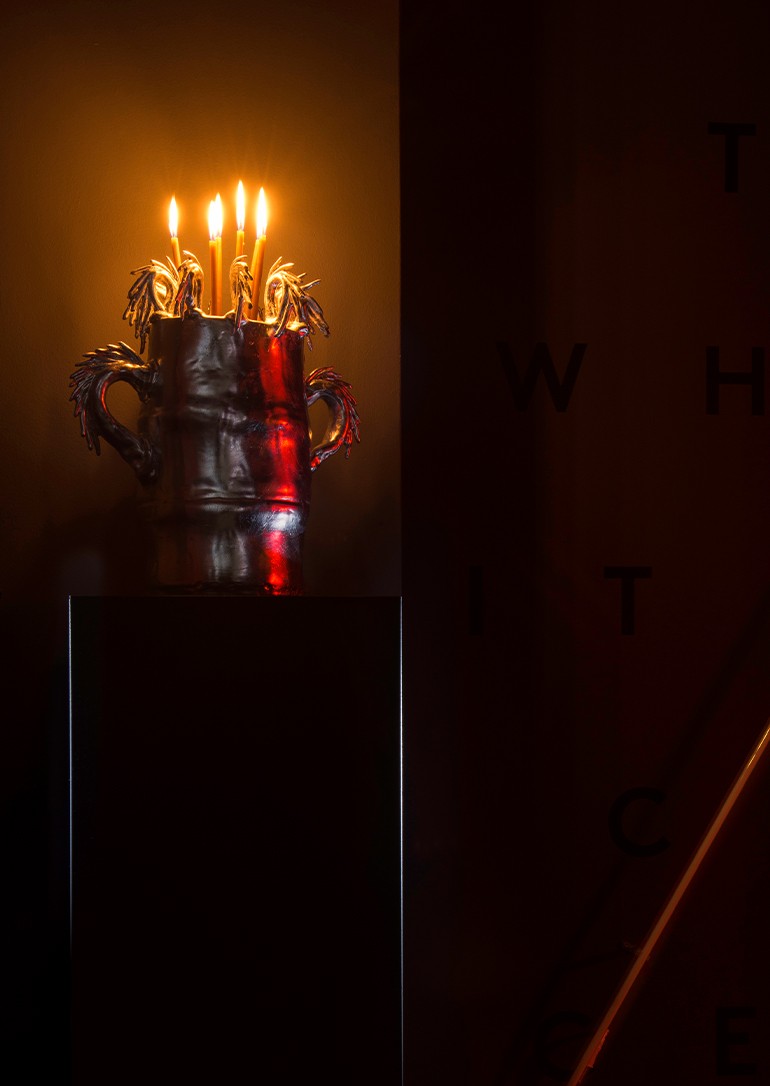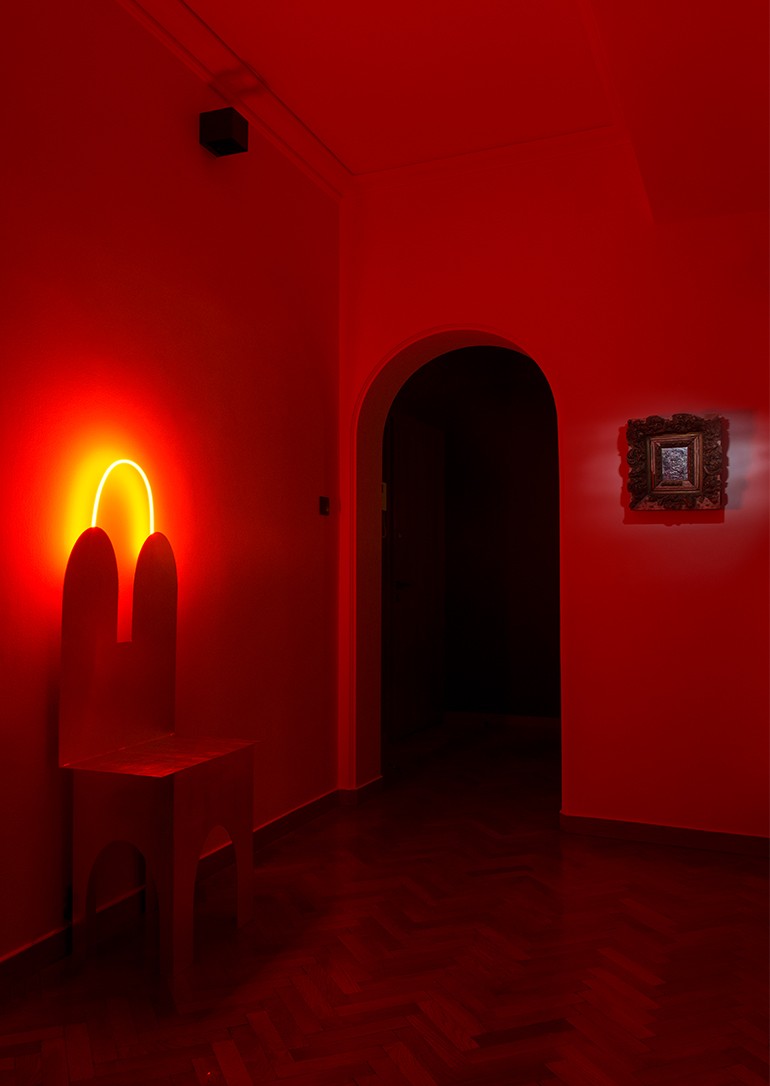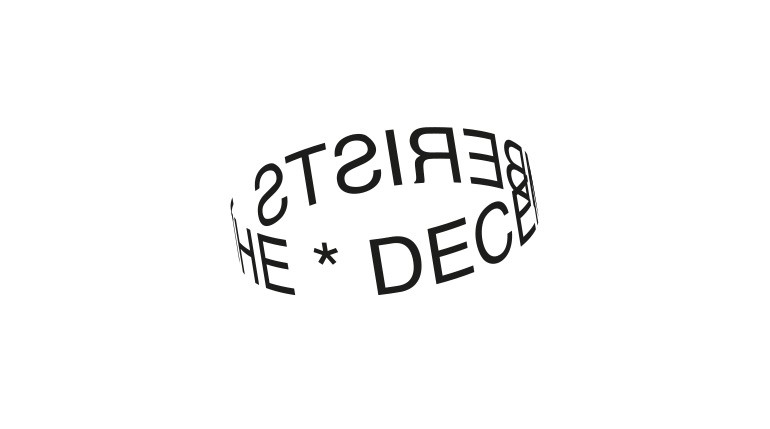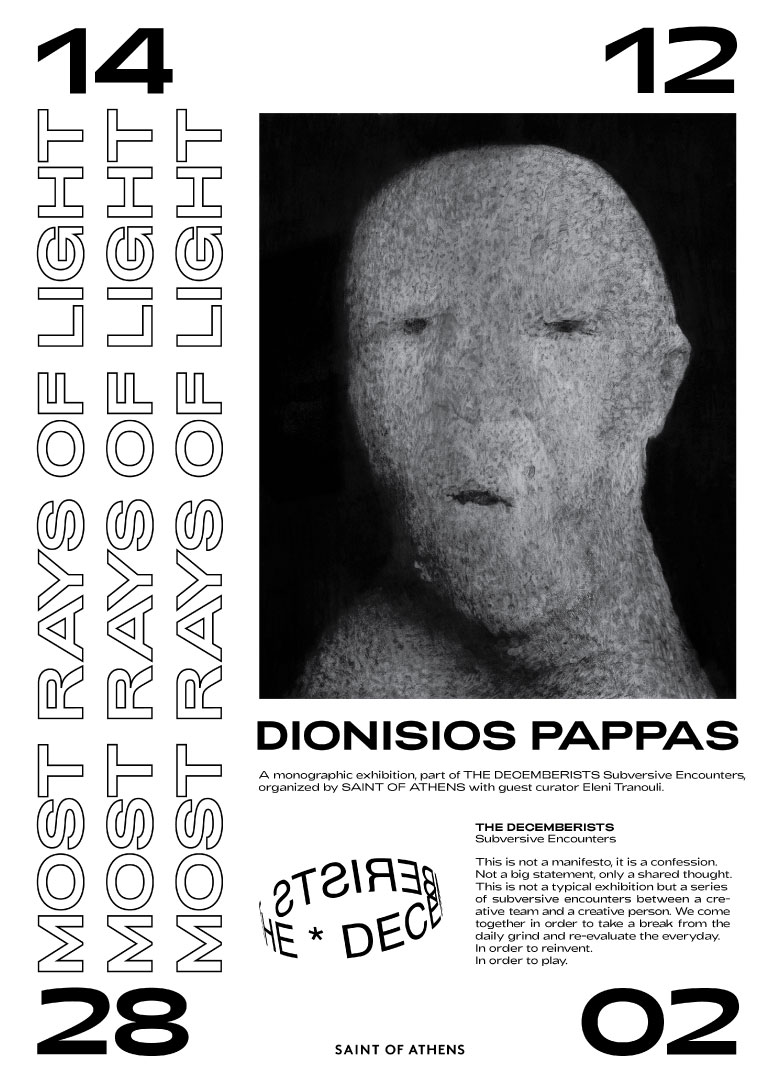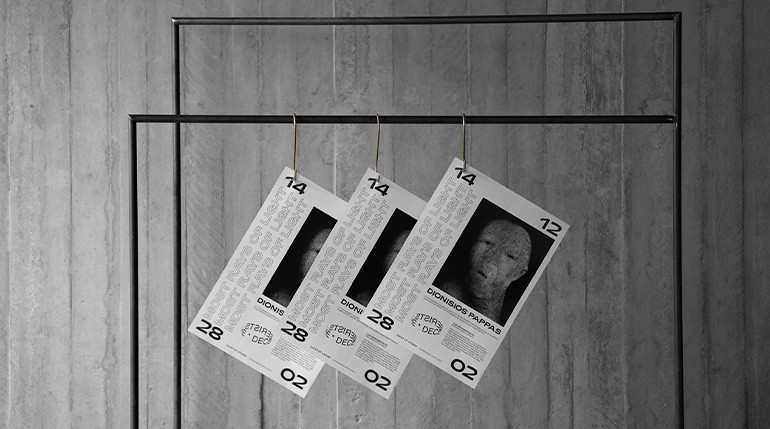THE DECEMBERISTS
Subversive Encounters
This is not a manifesto, it is a confession.
Not a big statement, only a shared thought.
This is not a typical exhibition but a series of subversive encounters between a creative team and a creative person.
We meet in order to take a break from the daily grind and re-evaluate the everyday.
In order to reinvent.
In order to play.
Vol. 2
ALEXANDROS DOURAS: AS CEPHALOPHORIC SAINTS
“Τέμνῃ κεφαλήν· καὶ τὸ λοιπὸν ὡς μέγα!
Ἄρας γὰρ αὐτήν, Διονύσιε, τρέχεις.”
(The Orthodox Church “Synaxarion” i.e. Book of the Lives of Saints – Chapter of the 3rd of October, Commemoration day of Saint Dionysius the Areopagite)
Saints portrayed in Christian art often carry objects that depict the ritual of their martyrdom in a dense and eloquent form of symbolism. There is a distinct category of martyrs however that are commonly shown carrying their own head. Known as cephalophores, literally “head-carriers” in Greek ( “κεφαλή” + “φέρω”), these headless saints signify that they suffered martyrdom by decapitation.
St. Denis of Paris is the most prominent cephalophore in Christian tradition. According to the legend the decapitated bishop miraculously preached with his head in his hands, while journeying the seven miles from Montmartre, the site of his martyrdom, to his burying place, where St Denis Basilica was built.
Although St Denis of Paris lived in the 3rd century AD he is commonly identified with Dionysius the Areopagite who was converted to Christianity by St. Paul and served as the first bishop of Athens in the 1st century AD. Dionysius is venerated in the Orthodox Church as the patron saint of Athens. In the book of the Orthodox Church Lives of Saints, Dionysius is honoured as a cephalophore.
Cephalophory is probably the most dramatic evidence of a saint’s triumph over death. In his essay “Disembodied Heads in Medieval and Early Modern Culture”, Scott Montgomery argues that “the act of post-decapatory ambulation (and occasionally locution) is underscored as all-the-more miraculous.” In religious context, as well as in literature and medieval and Renaissance art, such tropes reinforce the perception of Man‘s dual nature: body and mind, flesh and spirit are linked together so strongly that they have become inseparable.
In the work of Alexandros Douras sculpture deploys its power on radically different materials, marking a significant coexistence, while inaugurating a dialectic act on the miracle of artistic creation. Clay, a primary and totally natural art material, and neon light, an artificial yet popular technological product, are envisaged as the two poles of a creative continuum.
In “Cruising Park” (2018) Douras organises a visual representation of mingling and coexistence, while pointing out similarities and significant analogies: clay, as well as neon light are too fragile, whilst at the same time both materials have proven their extreme durability through time.
In his current installation in Saint of Athens the artist focuses on the human dualism allegory, with neon as the intellectual output of a scientific invention and clay representing the output of handicraft. Douras creates sacred neon halos, triumphantly placed over glossy abstract clay headless figures. To the existential anxiety of humans he replies with a harmonious conjunction of materials, that brings us amidst a visual landscape, “blessed” with the notion of miracle. His sculptures are headless yet haloed and self-luminous, divided yet holy, decapitated yet expressive.
More of a devout scenery than an exhibition, “as cephalophoric saints” is an experiential journey through darkness and light, flesh and spirit. Clay candelabra, neon halos and a golden, fully instagrammable throne pay tribute to human mindfulness, “this fine specimen of hypermagical ultraomnipotence” as seen by E.E. Cummings, while dark clay per se underscores the subversive character of the whole encounter.
Within walking distance from Dionysius the Areopagite church in Athens, Alexandros Douras’ sculpture triggers a clear, soothing concept: in the swirl of life, the inner call for dignity and the constant effort to conquer, hold and bravely defend the valuable and unique self, equal to human miracles. Because, in this sense, we all walk in life as cephalophoric saints.
Effie Kassoura
SOUNDSCAPE
Stavros Gasparatos
Vol. 1
DIONISIOS PAPPAS: MOST RAYS OF LIGHT
Since white is the color that reflects the most rays of light,and thus is most easily perceived, a beautiful body will be all the more beautiful the whiter it is.
Johann Joachim Winckelmann
The seminal book History of the Art of Antiquity (1764) by Johann Joachim Winckelmann, marked a radical shift in the Western world's perception on ancient Greek art. Its glorification of Classical antiquity sparked off Neoclassicism and irrevocably redefined our conception of our past. Disregarding the fact that ancient Greek and Roman sculptures were originally painted with bright colors, Winckelmann argued that white marble represents the unblemished beauty and absolute truth, influencing a great number of thinkers. From his book, a very controversial phrase is often requoted: "Since white is the color that reflects the most rays of light, and thus is most easily perceived, a beautiful body will be all the more beautiful the whiter it is".
Dionisios Pappas, with a background in archaeology, often draws images and symbols of classical sculptures in order to challenge modern preconceptions about identity, single principles and centralized ideals that are deeply rooted in our understanding of Ηistory and, by consequence, our view of ourselves and others. Intentionally using paper in his work, he makes a case for a fragile and shattered view of the material body and the self. Familiar images of a glorious past become the ephemeral, dark ruins of today. Pappas’ sculpture Venus (2017) is made from multiple pictures of the face of the Greek Goddess. He decisively opens holes in the face, disturbing its beauty and allowing the viewer to look through and beyond the multi-layered image. As if an image must be pierced in order to reveal a deeper meaning.
In his series Dolls (2017), the artist moves away from archaeological references to use dissected vintage children's dolls as his canvas. In search of a new skin, he overlays them with photocopies of himself to cover the plastic flesh. Through these inky effigies, a new, intimate identity is restored. Another tender artwork linked to childhood is Portrait I (2015), inspired by a photo of the artist’s mother. The image of the face is shaped through multiple layers of the same folded photo, giving the impression of a vibrating liquid surface when a pebble drops in water. In Head A / Head B (2018), the artist creates disproportioned replicas of his head that look like a nightmarish snapshot of himself, as perceived by others. An idea that penetrates his large-scale pencil drawings Head I / Head II (2017), immersed in darkness. Their features are blurred, and they look back at us like a transmuted image of ourselves.
In the 18th century, Winckelmann used a causal explanation to prove the superior aesthetic purity of a material over another (and of a civilisation over another) based on its property to reflect "the most" rays of light. Today, Dionisios Pappas, a modern offspring of the "white marble ideal", caught between an idealised past and a globalised present in decay, tries to subvert any absolute or dominant belief. Instead, he suggests a prismatic perspective of the world and a decentered, diversified view of things and of oneself. Truly, what the world needs is more rays of light. More and more.
Eleni Tranouli
(Bio)
Dionisios Pappas (1974) was born in Athens and, throughout his school years, he frequented the Art Studio of Dimitris Mytaras in Chalkida. It is where he first developed a flair for art. Years later, his long studies in archaeology and Byzantine archaeology will find their way into his work as an artist. His works with paper because "paper, part of our everyday life, is the canvas of the first children's drawings; due to its vulnerability, the fragility is interwoven with the temporary". For Pappas, ugliness is seen in people's aggression which he has experienced himself. He is a savvy collector of kitsch lighters that he used when he was a smoker. A childhood memory he recalls is the smell of a sandlot friend. Many years later, when he ran into the same smell again, he immediately remembered the original.
"Dionisios Pappas: Most Rays of Light" is a monographic exhibition, part of THE DECEMBERISTS Subversive Encounters, organized by SAINT OF ATHENS with guest curator Eleni Tranouli.
